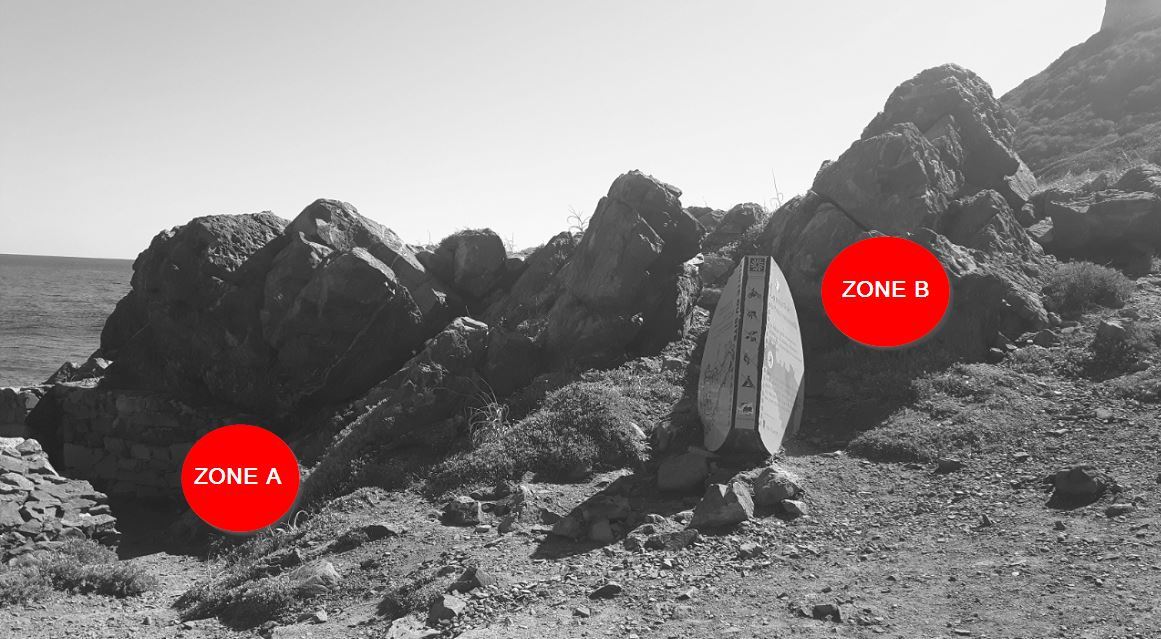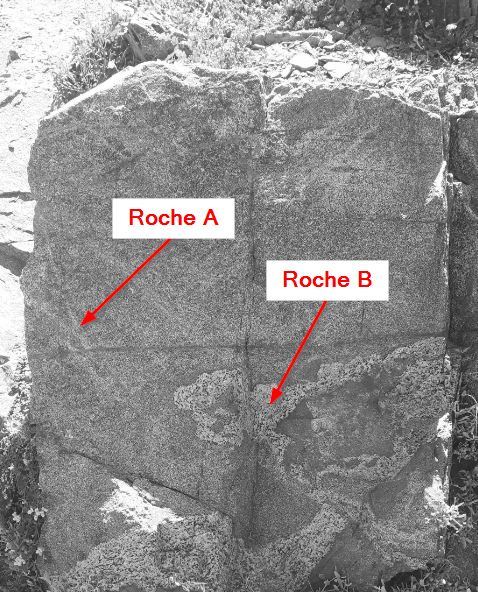
La Earthcache / The Earthcache
L'île de Beauté présente une diversité géologique remarquable, héritée d'une histoire des temps géologiques souvent tumultueuse.
Elle est divisée en deux grandes parties, une corse hercynienne ancienne qui a connu les grandes perturbations de l'orogenèse hercynienne à la fin du Paléozoïque et une corse alpine plus jeune, issue des mouvements à l'origine de la chaîne des Alpes
La presqu'île de la Parata, à l'ouest d'Ajaccio, est un endroit idéal pour découvrir certains particularités géologiques héritées de l'orogenèse hercynienne.
► Contexte géologique local
Après avoir quitté la région d'Ajaccio caractérisée par un massif granitique pour prendre la direction de l'ouest, nous pénétrons dans un ensemble géologique complètement différent, comme le montre la carte ci-dessous.

Nous sommes en présence d'un plutonisme granodioritique avec de remarquables intrusions de gabbro.
Ce gabbro-diorite forme la totalité de la presqu’île de la Parata.
Ces roches magmatiques plutoniques se sont mise en place lors de l’intrusion calco-alcaline de la fin du Paléozoïque, entre -305 et -280 Ma.
Ces ensembles alcalins ont ensuite refroidi et ont été ramenés à la surface par érosion des couches supérieures lors d'une longue période d’exondation à l’Ère Mésozoïque.
Pour finir, des alternances d'immersion et d’émersion de la presqu’île (en fonction du niveau de la Méditerranée) se succèdent à la fin du Cénozoïque, amenant par moment des dépôts de grès coquillier calcaire qui témoigne d’un ancien niveau de stationnement de la mer entre + 1 et + 2 mètres d’altitude.
► Les roches de la Parata
~ Le Gabbro
Le gabbro est une roche plutonique magmatique, à texture grenue, composée essentiellement de pyroxène et de feldspath. Il est le constituant principal de la couche inférieure de la croûte océanique. On le trouve ailleurs que sur Terre, le gabbro composant une partie des roches de la surface de la Lune.
Cette roche est issue de la fusion partielle de la péridotite mantellique au niveau de la dorsale ayant subi, contrairement au basalte, un refroidissement lente et une cristallisation complète.
Cela va donner par une roche grenue de couleur dominante verte à noire, avec des grains visibles à l’œil nu. Ces cristaux ont cependant une taille moyenne, de l'ordre du millimètre.

Le gabbro se caractérise par la présence d'olivine, un minéral du groupe des silicates qui va conférer une couleur verte à la roche.

~ La Diorite
La diorite est une roche magmatique plutonique grenue composée de plagioclase, d'amphibole verte (hornblende) et de mica.
Elle se distingue du gabbro par l'absence d'olivine.
La diorite est généralement une roche claire, parsemée de zones plus sombres, à texture grenue. Elle est constituée de grands cristaux vert très foncés tirant sur le noir d’amphibole, d’autres blancs laiteux étant du feldspath et d’autres translucides étant du quartz. Cet assemblage minéralogique est lié à un refroidissement lent caractéristique d'un magma chimiquement intermédiaire entre un magma granitique et un magma basaltique.
Dans l'ensemble de la Parata, ce refroidissement particulièrement lent à donner naissance à des phénocristaux d'amphibole, cristaux de plus de 1 cm de long.

~ Le grès coquillier calcaire
A la différence des roches précédentes, le grès coquillier calcaire est une roche sédimentaire détritique, issue du dépôt des éléments érodés d'un calcaire coquiller.
Les sédiments de ce grès sont visibles à l’œil et présentent une taille millimétrique (équivalent à des grains de sable).
De couleur uniformément blanche, c'est une roche beaucoup plus tendre et beaucoup plus récente que les roches plutoniques gabbro-dioritiques sur lesquelles elle repose.

Du fait de sa fragilité, cet ensemble géologique a quasiment disparu de la pointe de la Parata, victime de l'érosion, et il n'en reste que quelques traces observables.
Corsica has a remarkable geological diversity, inherited from a history of geological times often tumultuous.
It is divided into two large parts, an old Hercynian corsican that experienced the great disturbances of the Hercynian orogeny at the end of the Paleozoic and a younger Alpine Corsican, resulting from the movements at the origin of the chain of the Alps.
The peninsula of Parata, west of Ajaccio, is an ideal place to discover certain geological peculiarities inherited from the Hercynian orogeny.
► Local geological context
After leaving the region of Ajaccio characterized by a granite massif to take the direction of the west, we enter a completely different geological unit.
Indeed, we are in the presence of granodioritic plutonism with remarkable intrusions of gabbro.
This gabbro-diorite forms the entire peninsula of Parata.
These plutonic magmatic rocks were emplaced during the Calco-alkaline intrusion of the late Paleozoic, between -305 and -280 Ma.
These alkaline complexes were then cooled and brought to the surface by erosion of the upper layers during a long period of Mesozoic Eradication.
Finally, alternation of immersion and emersion of the peninsula (depending on the level of the Mediterranean) follow one another at the end of the Cenozoic, bringing at times deposits of limestone shell sandstone which reflects an old level parking of the sea between + 1 and + 2 meters of altitude.
► The rocks of Parata
~ Gabbro
The gabbro is a magmatic plutonic rock, with a granular texture, composed mainly of pyroxene and feldspar. It is the main constituent of the lower layer of the oceanic crust. It is found elsewhere than on Earth, the gabbro composing a part of the rocks of the surface of the Moon.
This rock originates from the partial melting of the mantle peridotite at the level of the dorsal zone, which has undergone, in contrast to basalt, slow cooling and complete crystallization.
This will give a grainy rock of dominant green to black color, with grains visible to the naked eye. These crystals, however, have an average size, of the order of one millimeter.
The gabbro is characterized by the presence of olivine, a mineral from the group of silicates that will give a green color to the rock.
~ Diorite
Diorite is a granular plutonic magma rock composed of plagioclase, green amphibole (hornblende) and mica.
It is distinguished from gabbro by the absence of olivine.
The diorite is usually a clear rock, dotted with darker, grainy-textured areas. It is made up of large, very dark green crystals that draw on amphibole black, other milky whites being feldspar and other translucent ones being quartz. This mineralogical assemblage is linked to a slow cooling characteristic of a chemically intermediate magma between a granitic magma and a basaltic magma.
In the whole of Parata, this cooling particularly slow to give rise to phenocrysts of amphibole, crystals more than 1 cm long.
~ Limestone shell sandstone
Unlike previous rocks, limestone shell sandstone is a detrital sedimentary rock, resulting from the deposition of eroded elements of a shell limestone.
The sediments of this sandstone are visible to the eye and have a millimetric size (equivalent to grains of sand).
Uniformly white in color, it is a much softer and much more recent rock than the gabbro-dioritic plutonic rocks on which it rests.
Because of its fragility, this geological ensemble has almost disappeared from the tip of Parata, a victim of erosion, and only a few traces remain.
► Sources bibliographiques / Bibliographical sources
Les Questions / The Questions
La lecture attentive du descriptif de la cache, ainsi qu'une observation des éléments de terrain et un peu de déduction sont normalement suffisants pour répondre aux questions de cette EarthCache.
A careful reading of the description of the cache, as well as observation of terrain features and some deduction is usually sufficient to answer questions of this EarthCache.
Questions pour valider :"Les roches de la Parata"
Questions to validate: "The rocks of Parata"
Point 1 : N 41° 53.792 E 008° 36.619
Vous voici devant un ensemble de roches affleurant de part et d'autre d'un panneau d'indication. Nous allons observer les deux zones A et B de la photo WP1.
Here you are in front of a set of rocks flush on both sides of an indication panel. We will observe the two zones A and B of photo WP1.

Approchez-vous de la zone A et repérer l’affleurement de la photo WP1-Zone_A.
Approach zone A and spot the outcrop of photo WP1-Zone_A.

- Question 1 : Décrivez la roche A (granularité, dureté, couleur, taille des cristaux). De quelle roche s'agit-il ?
- Question 1 : Describe rock A (granularity, hardness, color, crystal size). What rock is it?
- Question 2 : Décrivez la roche B (granularité, dureté, couleur, taille des cristaux). De quelle roche s'agit-il ? Donnez la taille moyenne et la nature des plus grand cristaux qui la compose. Comment pouvez-vous qualifier ses cristaux ?
- Question 2 : Describe Rock B (granularity, hardness, color, crystal size). What rock is it? Give the average size and nature of the largest crystals that compose it. How can you call his crystals?
Approchez-vous de la zone B et repérer l’affleurement de la photo WP1-Zone_B.
Approach zone B and spot the outcrop of WP1-Zone_B.

- Question 3 : Quelle est la couleur dominante de la roche sous la zone B ? Quel élément en est à l'origine ?
- Question 3 : What is the dominant color of the rock under zone B? What element is at the origin?
Point 2 : N 41° 53.795 E 008° 36.633
Vous voici devant affleurement de roche au sol (voir photo WP2).
Here you are in front of rock outcrop (see photo WP2).

- Question 4 : Décrivez la roche sous les zones vertes. De quelle roche s'agit-il ?
- Question 4 : Describe the rock under the green areas. What rock is it?
Vous pouvez vous loguer sans attendre notre confirmation,
mais vous devez nous envoyer les réponses en même temps soit par mail via notre profil (
fafahakkai), soit via la messagerie geocaching.com (Message Center).
S'il y a des problèmes avec vos réponses nous vous en ferons part.
Les logs enregistrés sans réponses seront supprimés.Une photo de vous ou de votre GPS avec la mer ou la pointe de la Parata en arrière plan est la bienvenue, mais n'est pas obligatoire.
You can log this cache without waiting for our confirmation, but you must send us the answers at the same time, by e-mail via our profile (fafahakkai) or by the system of Message Center of geocaching.com.
If there is a problem with your answers we will notify you. The logs recorded without answers will be deleted.
A photo of you or your GPS with the sea or the tip of Parata in the background is welcome, but not mandatory.
Rappel concernant les « Earthcaches »: Il n'y a pas de conteneur à rechercher ni de logbook à renseigner. Il suffit de se rendre sur les lieux, de répondre aux questions ci-dessus et de nous renvoyer les réponses.
Reminder concerning "Earthcaches": there is neither a container to look for nor a logbook to sign. One need only go to the location, answer to the differents questions and send us the answers.